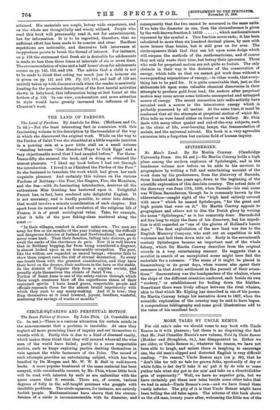SPITSBERGEN.
No Man's Land. By Sir Martin Conway. (Cambridge University Press. 10s. 6d. net.)—Sir Martin Conway holds a high place among the modern explorers of Spitsbergen, and in the handsome volume now before us he adds to his services to geographers by writing a full and entertaining account of the work done by his predecessors, from the discovery of Barends, three hundred and ton years ago, down to the beginning of the scientific exploration of this desolate country. The actual date of the discovery was June 17th, 1596, when Barends—his real name was Willem Barendszoon, though he is commonly known by the abbreviation—caught sight of the " high land entirely covered with snow " which he named Spitsbergen, " for the great and high points that were on it." Sir Martin Conway appeals to geographers and others not to dim the Dutch glory by writing the name " Spitzbergen," as is too commonly done. Barends did not live long to enjoy the fame of his discovery, but his expedi- tion is still regarded as "one of the glories of Holland's heroic days." The first exploitation of the new land was due to the English Muscovy Company, who sent out an expedition to kill walruses and boil them down into oil. Early in the seventeenth century Spitsbergen became an important seat of the whale fishery, which Sir Martin Conway describes from the original records in a very entertaining manner. He suggests that a novelist in search of an unexploited scene might here find the materials for a romance. " The scene of it might be placed in Smeerenburg in its great days, when women also spent their summers in that Arctic settlement in the pursuit of their avoca- tions." Smeerenburg was the headquarters of the whalers, where the ships of the different countries anchored, each beside its own " cookery," or establishment for boiling down the blubber. Sometimes there were lively affrays between the rival whalers, akin to that which Mr. Kipling has described in one of his poems. Sir Martin Conway brings his narrative down to 1837, when the scientific exploration of the country may be said to have begun. A compendious bibliography and some good illustrations add to the value of his excellent bock.


























































 Previous page
Previous page